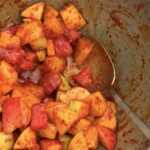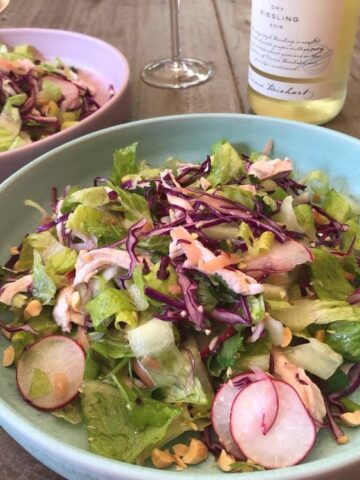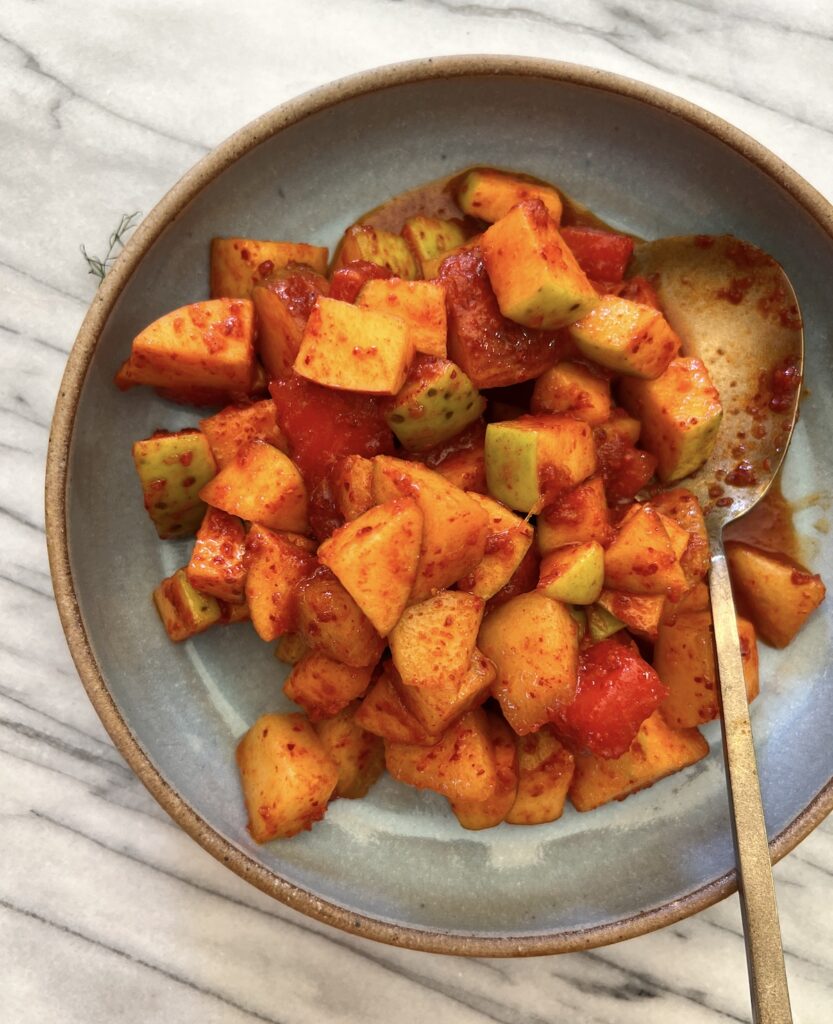
My knowledge of Korean cooking is quite limited, which is why I’m always looking for ideas beyond the usual grilled meaty meals. I enjoy those feasts but the Korean banchan – side dishes, are what captivate me. They can vary in textures, colors, and flavors. Banchan are served to balance flavors and add extra nutrition to meals. However, I admit that when presented with half a dozen (or more) banchan, my tastebuds get overloaded. The result can be a muddled eating experience. It’s hard to taste the main ingredients because the seasonings are driving the bus. Sometimes I just want a little something Korean to add to a meal.
Cue Eric Kim’s very delicious, super easy, and versatile dressing for muchim, which means to “mix with seasonings” in Korean. Soybean sprout muchim is a classic, and there’s a great recipe by Maangchi at her website. I’d not seen muchim featuring fruit until I opened Eric Kim’s debut best seller, Korean American. His recipe, quirkily titled “One Dressing, a Thousand Fruit Muchim” caught my attention. He pushes boundaries with his recipes, but they are always very approachable because they’re based on solid foundations built on his family’s experiences in Korea and America. His mother is an excellent, thoughtful cook.
Having made a number of recipes in Korean American, such as the crunchy soy sauce fried chicken with jalapeños, I know that Eric’s flavors are skillfully calibrated. His muchim reminded me of the Viet way of eating unripe tart fruit, such as green mango, with chile salt. That’s likely why I found it so alluring. It spoke to me. The difference is that for this Korean muchim, you may use sweet, ripe fruit. If you’re a bit skeptical, my notes should help you along.
Gochugaru Options
What’s needed for the dressing is straightforward. However, you may not have gochugaru in your pantry. The dried, ground chile is a Korean staple ingredient – what is used for preparing many kinds of kimchi. I purchase a bag from a Korean grocer and keep it my freezer for years. It’s sold at many East Asian and pan-Asian markets. When shopping for gochugaru, you’ll see packages labeled with different textures and oftentimes, heat levels. (Scroll down this blog post recipe to for a sample package of gochugaru and gochujang, another key Korean ingredient.)
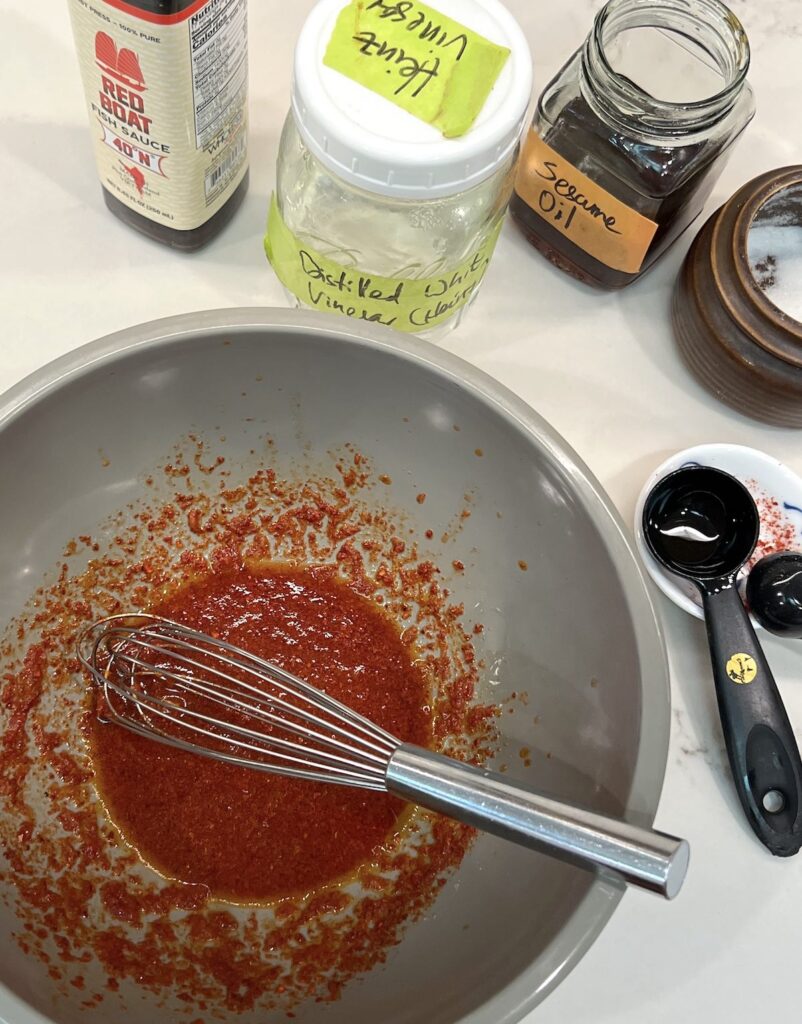
What to buy? I hedge by choosing a coarse texture, and if there’s a heat level mentioned on the package, I go for medium heat. I figure that I can always grind up coarsely textured gochugaru if I need something finely textured. And, I can use more gochugaru if I want more heat. I typically buy a one-pound bag like this one, but there are smaller options, like this one. It lasts for many years in the freezer.
How to substitute for gochugaru? I don’t recommend subbing if you want to match Eric’s Korean flavors. But if you have to, consider these gochugaru substitution options:
Best: 1 ½ to 2 teaspoons of gochujang, Korean fermented chile paste, which can be found at many markets nowadays in the Asian ingredients section
Good: 1 ½ to 2 teaspoons ground Kashmir chile, which is moderately hot with bright color and flavor to match that of gochugaru
Okay: 1 tablespoon chile-garlic sauce (back off the raw garlic by a smidgen; you may need to up the sugar a bit)
In a pinch: 2 teaspoons paprika + 1 teaspoon cayenne
Fruity Selection and Prep
You can use any fruit or fruit-ish vegetables for this mix. For this round, I had apples, pear, and melon on hand, but I’ve also combined cucumber, pear, and grapes. Eric suggests tomato, cucumbers, zucchini and much more, as you’ll see in the recipe below. What you select will tilt the resulting dish toward savory, sweet-savory, or even tangy-savory (depending on ripeness). The correcting factor is the dressing, which is tangy, pungent, spicy, and umami.
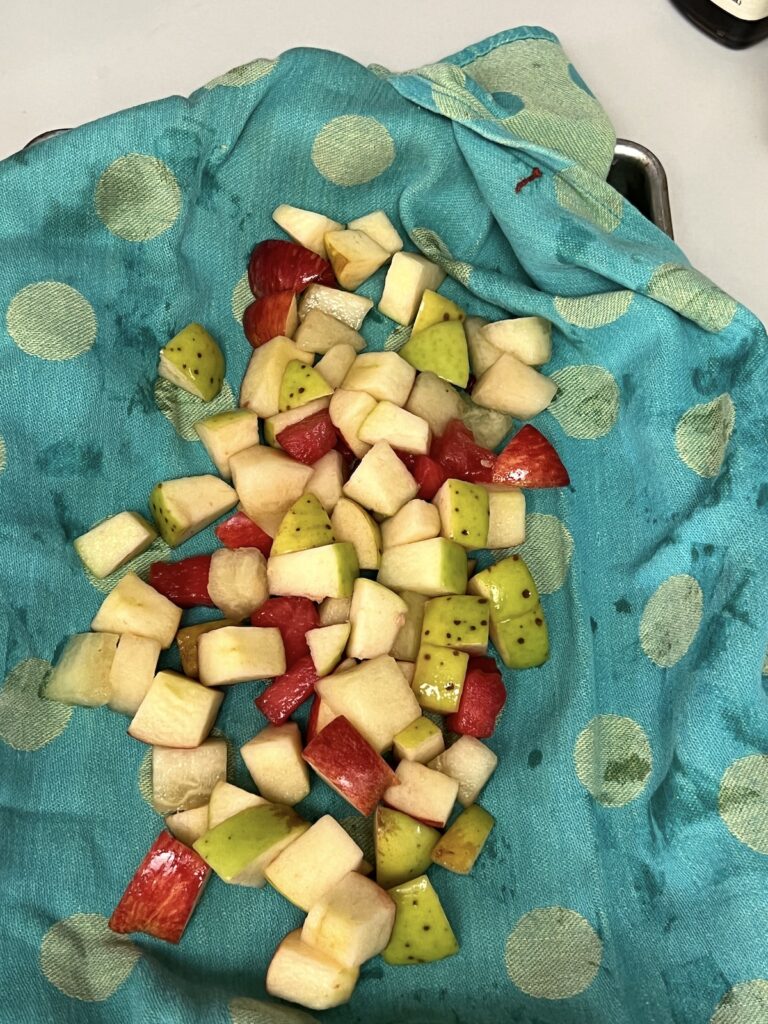
Why salt the fruit? It releases liquid so the fruit pieces better absorb the dressing. Think of a dryish sponge. The salted fruit is sturdier too. It’s a bit strange to pat fruit dry but you need to do it.
Muchim Pairings and Serving Suggestions
You don’t have to serve an array of banchan to enjoy the splendors of this Korean fruit salad. It’s great with a sandwich or rice bowl, for example. I can see putting it in a lettuce wrap too. It comes with its own sauce! But it would be fun served with these dishes:
- Soy Sauce Fried Chicken with Jalapeños
- Korean Fried Chicken Nuggets
- Pajeon scallion pancakes
- Spicy rice cakes (Tteokbokki)
- Chilled cucumber and seaweed soup (Ohyi Miyuk Naeng Guk)
- Beef Tofu Patties (Wanjajeon)
Now, here’s the recipe so you can go at it yourself!
One Dressing, a Thousand Fruit Muchims
Ingredients
For the fruit
- 1 pound mixed fruit, cut into bite-size pieces (like tomatoes, cucumbers, zucchini, sweet Peppers, watermelon, cantaloupe, honeydew, pineapple, mangoes, peaches, plums, pears, apples, or cherries, fuyu persimmon, stemmed seeded and or cored)
- ¾ teaspoon fine sea salt, 1 teaspoon Morton’s kosher salt, or 1 ½ teaspoon Diamond Crystal kosher salt
For the dressing
- 2 tablespoons distilled white vinegar
- 1 large garlic clove, finely grated
- 1 tablespoon plus 1 teaspoon toasted sesame oil
- 1 tablespoon gochugaru
- 2 teaspoons fish sauce
- 1 teaspoon sugar
Instructions
- Prepare the fruit: in a medium bowl, toss the fruit with the salt, transfer the fruit to a colander, and let sit in the sink to drain, about 30 minutes.
- Meanwhile, make the dressing: in the same bowl you just use for the fruit combine the vinegar and garlic and set aside for 30 minutes to allow the garlic to mellow.
- After 30 minutes, to the vinegar and garlic mixture, add the sesame oil, gochugaru, fish sauce, and sugar and whisk to combine.
- Use a paper towel or cloth kitchen towel to pat the fruit dry, then add to the dressing and toss until well coated. This muchim is best eaten right away, but can be refrigerated for up to 48 hours, after which the bright flavors will start to mute and the dressing will break down the fruit.
- To grate the garlic, use a rasp-style grater.













